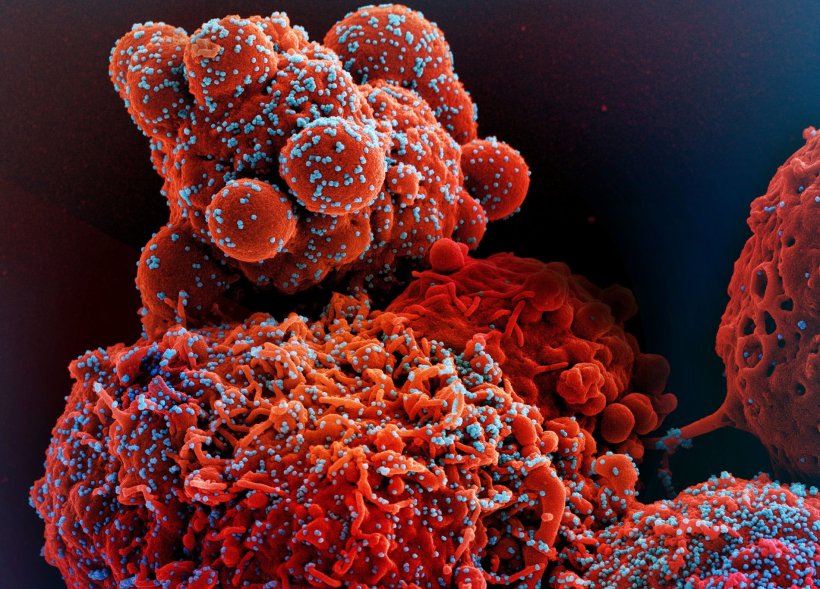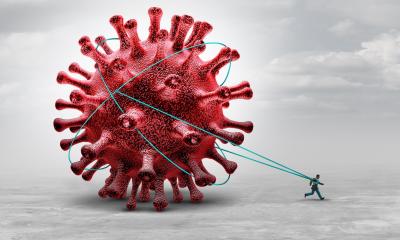
Image credit: NIAID (CC BY 2.0)
News • Sars-CoV-2 research
Coronavirus produces 'dummy' proteins to fool the immune system
To evade the human host’s immune response, Sars-CoV-2, the coronavirus that causes Covid-19, uses the machinery of defense cells to induce the expression of unproductive isoforms of key antiviral genes – variant forms of genes that result from disrupted splicing or transcription processes and do not code for functional (protective) proteins.
This is a key finding of a study conducted by researchers at the Albert Einstein Jewish Brazilian Hospital (HIAE), the University of São Paulo (USP) and the Federal University of Minas Gerais (UFMG). An article on the study, which offers a foundation for the development of novel therapeutic strategies to combat Covid-19, is published in the International Journal of Molecular Sciences.
Other viruses, including coronaviruses, also distort protein production by disrupting messenger RNA (mRNA) splicing, but Sars-CoV-2 goes further by blocking expression of interferons, a family of proteins that help the immune system fight infection, and modulating specific immune cells. A lack of precise details regarding this process has been a major hindrance to the development of novel options to treat Covid-19.
Recommended article

Article • Covid-19
Coronavirus update
Years after the first outbreak and spread of coronavirus Sars-CoV-2, its impact can still be felt in everyday life. Keep up-to-date with the latest research news, political developments, and background information on Covid-19.
In the study, which was funded by the São Paulo Research Foundation (FAPESP), the researchers set out to confirm the hypothesis suggested in the scientific literature that production of unstable mRNA isoforms can give rise to non-functional proteins. To do this, they conducted an integrative analysis that combined several transcriptomic and proteomic datasets to arrive at a detailed characterization of the infected host cell landscape, both in vitro and in vivo. They found that infection by Sars-CoV-2 induced predominant expression of unproductive splicing isoforms in key genes linked to the immune system and antiviral response (IFN signaling genes, ISGs, class I MHC genes, and splicing machinery genes such as IRF7, OAS3, HLA-B and HNRNPH1). These genes also produced fewer “normal” proteins, which in turn were more susceptible to attack by viral proteins.
The emergence of Sars-CoV-3, Sars-CoV-4, and so on, is perfectly plausible. The more we find out about the way these viruses work, the better
Helder Takashi Imoto Nakaya
On the other hand, inflammatory cytokine and chemokine genes (such as IL6, CXCL8 and TNF) mainly produced productive splicing isoforms in response to the infection.
“Although more than 50 papers on Covid-19 transcriptomics have been published, this is the first time this viral strategy has been demonstrated at the molecular level. Moreover, we used only publicly available data,” said Glória Regina Franco, full professor in the Institute of Biological Sciences (ICB) at UFMG and last author of the article.
“By demonstrating the molecular interaction between Sars-CoV-2 and the host’s splicing machinery, we provide fundamental information on potential targets for antiviral medications and immunomodulatory interventions. Our findings can be used to orient therapies that restore normal RNA processing during viral infections, for example,” said Helder Takashi Imoto Nakaya, a senior researcher at HIAE, a professor at USP’s School of Pharmaceutical Sciences (FCF), and penultimate author of the article.
Although the Covid-19 pandemic is over, new publications on the subject are always important, Nakaya said. “Novel coronaviruses can cause severe pandemics. The emergence of Sars-CoV-3, Sars-CoV-4, and so on, is perfectly plausible. The more we find out about the way these viruses work, the better,” he added.
More research on the damage caused by the virus at the molecular level is also important in light of the widespread reports of long Covid, a problem faced by millions of people worldwide and increasingly neglected.
Researchers at Indiana University and Michigan State University in the United States also took part in the study. Besides FAPESP, the funders included CAPES (the Brazilian Ministry of Education’s Coordination for the Improvement of Higher Education Personnel), CNPq (the National Council for Scientific and Technological Development, an arm of the Ministry of Science, Technology and Innovation), and the Research Pro-Rectorate of the Federal University of Minas Gerais (PRPq-UFMG).
Source: São Paulo Research Foundation; text: Julia Moióli (CC BY-NC 4.0)
22.08.2024











